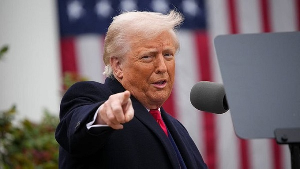 US President Donald Trump
US President Donald Trump
A trade war between the world’s two biggest economies is now in full swing.
Chinese exports to the US face up to 245% tariffs, and Beijing has hit back with a 125% levy on American imports. Consumers, businesses and markets are braced for more uncertainty as fears of a global recession have heightened.
Chinese President Xi Jinping’s government has repeatedly said it is open to dialogue, but warned that, if necessary, it would “fight to the end”.
Here’s a look at what Beijing has in its arsenal to counter US President Donald Trump’s tariffs.
China can take the pain (to a point)
China is the world’s second-largest economy, which means it can absorb the impacts of the tariffs better than other smaller countries.
With more than a billion people, it also has a huge domestic market that could take some of the pressure off exporters who are reeling from tariffs.
Beijing is still fumbling with the keys because Chinese people are not spending enough. But with a range of incentives, from subsidies for household appliances to “silver trains” for travelling retirees, that could change.
And Trump’s tariffs have given the Chinese Communist Party an even stronger impetus to unlock the country’s consumer potential.
The leadership may “very well be willing to endure the pain to avoid capitulating to what they believe is US aggression”, Mary Lovely, a US-China trade expert at the Peterson Institute in Washington DC, told BBC Newshour earlier this month.
China also has a higher threshold for pain as an authoritarian regime, as it is far less worried about short-term public opinion. There is no election around the corner that will judge its leaders.
Still, unrest is a concern, especially because there is already discontent over an ongoing property crisis and job losses.
The economic uncertainty over tariffs is yet another blow for young people who have only ever known a rising China.
The Party has been appealing to nationalist sentiments to justify its retaliatory tariffs, with state media calling on people to “weather storms together”.
President Xi Jinping may be worried but, so far, Beijing has struck a defiant and confident tone. One official assured the country: “The sky will not fall.”
China has been investing in the future
China has always been known as the world’s factory – but it has been pouring billions into becoming a far more advanced one.
Under Xi, it has been in a race with the US for tech dominance.
It has invested heavily in homegrown tech, from renewables to chips to AI.
Examples include the chatbot DeepSeek, which was celebrated as a formidable rival to ChatGPT, and BYD, which beat Tesla last year to become the world’s largest electric vehicle (EV) maker. Apple has been losing its prized market share to local competitors such as Huawei and Vivo.
Recently Beijing announced plans to spend more than $1tn over the next decade to support innovation in AI.
US companies have tried to move their supply chains away from China, but they have struggled to find the same scale of infrastructure and skilled labour elsewhere.
Chinese manufacturers at every stage of the supply chain have given the country a decades-long advantage that will take time to replicate.
That unrivalled supply chain expertise and government support have made China a formidable foe in this trade war – in some ways, Beijing has been preparing for this since Trump’s previous term.
